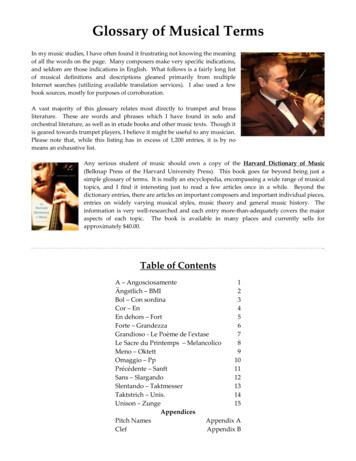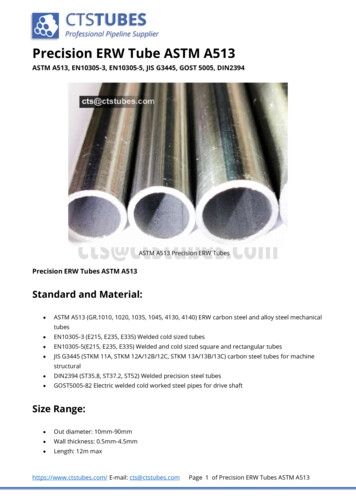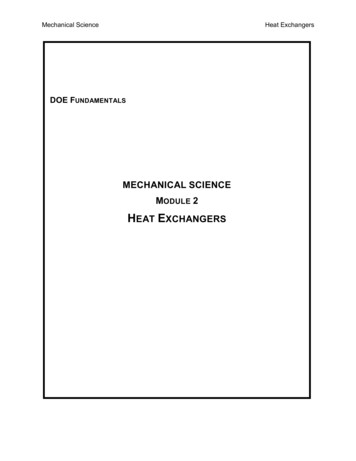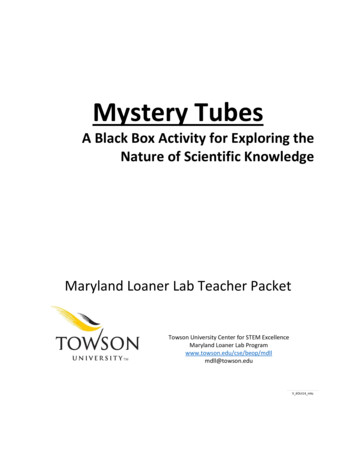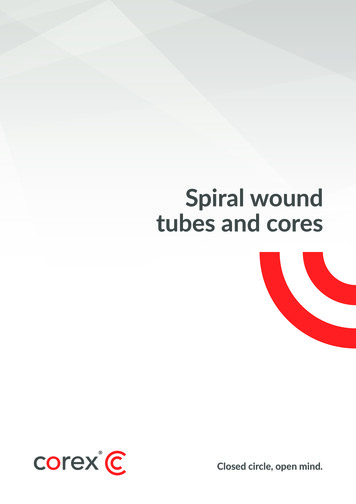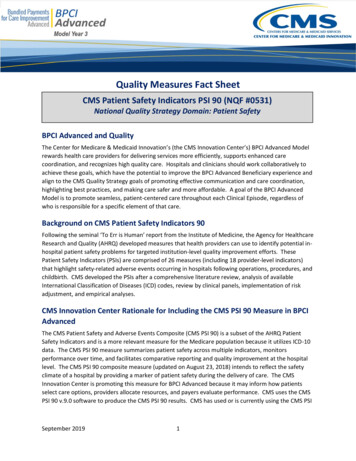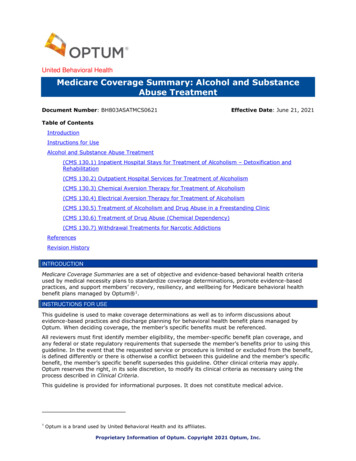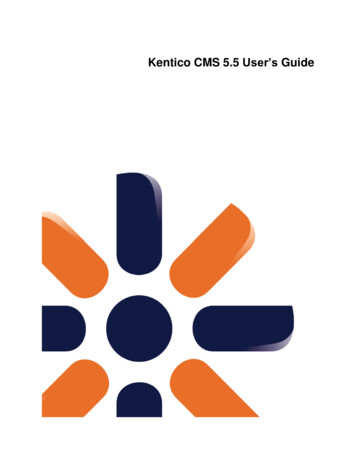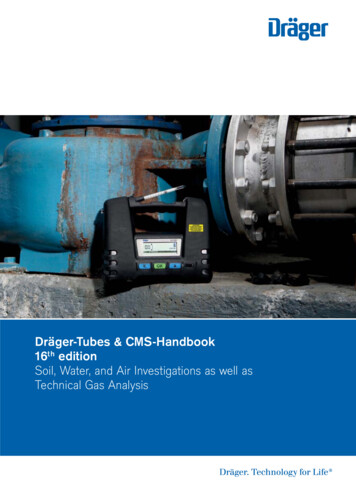
Transcription
D-23590-2010Dräger-Tubes & CMS-Handbook16th editionSoil, Water, and Air Investigations as well asTechnical Gas Analysis
Dräger-Tubes & CMS HandbookSoil, Water, and Air Investigations as well asTechnical Gas Analysis16th EditionDräger Safety AG & Co. KGaA,Lübeck, 2011
2 Dräger-Tubes & CMS-Handbook
3This handbook is intended to be a reference source for the user. The information has beencompiled to the best of our knowledge from relevant reference sources. However, the Drägerorganisation is not responsible for any consequence or accident which may occur as theresult of misuse or, misinterpretation of the information contained in this handbook.The instructions for use may not always correspond to the data given in this book. For afull understanding of the performance characteristics of the measurement devices and forthe use of the Dräger products only the instructions for use enclosed with the productshall apply. The user should carefully read the instructions for use prior to the use of themeasurement devices.Furthermore, the Dräger organization has attempted to provide current factual informationregarding industrial hygiene standards and occupational exposure levels, but insomuch asthese standards and levels are being revised periodically, the user should consult currentlocal, state and federal regulations.Technical data are subject to modifications.Publisher: Dräger Safety AG & Co KGaADräger-Tube/CMS Handbook: Handbook for short term measurementsin soil, water and air investigations as well as technical gas analysis.Lübeck, 2011ISBN 3-926762-06-3 2011 Dräger Safety AG & Co. KGaARevalstrasse 1 I 23560 Luebeck I GermanyPrinted in GermanyEditorial Date: Feb. 2011ISBN 3-926762-06-3A
4 Dräger-Tubes & CMS-Handbook
5PrefaceSince the last edition, a range of new developments, improvements and modificationshave affected Dräger-Tubes measurement technology. The data section on the individualDräger-Tubes and systems has been expanded and updated. Many of the pictures of theDräger-Tubes that are described have been recreated, as it was possible to improve thecolor depth and color contrast of different tubes by using an optimized production method.A particular innovation is the new Dräger X-act 5000 ex-approved automatic tube pump,which is available upon publication of this edition. An "all-in-one concept" has been achievedwith a new pump concept. Whether taking short-term measurements with the proven DrägerTubes or sample taking with sampling tubes and systems – the pumps live up to practicalrequirements.The design of the present 16th Edition retains the layout and structure of the previousedition.Lübeck, February 2011Dräger Safety AG & Co. KGaAA
6 Dräger-Tubes & CMS-HandbookTable of Contents1.1.11.21.31.4GeneralIntroduction to Gas MeasuringConcentration, Specifications, and ConversionsWater Vapor and HumidityInformation System Dräger 2.122.132.142.152.162.172.18Dräger-Tubes and ApplicationsDräger-Tube MeasurementChemical Basics – Reaction MechanismsDräger-Tube Measurement SystemDräger-Tubes for Short-Term MeasurementsEvaluation of Dräger-TubesHot Air ProbeExtension HoseDetermination of Carbon Monoxide Content in Exhaled AirInvestigation of Compressed Air, Medical Gases, and Carbon DioxideProposed Strategy for Determining Gas HazardsMeasurement of FumigantsDetermination of Volatile Contaminants in Liquid SamplesDetection of Air FlowsDräger-Measurement-Systems for Long-Term MeasurementsExpiration Date, Storage, and Disposal of Dräger-TubesDräger-Sampling-SystemsMeasurement of Aldehydes and Isocyanates at the WorkplaceQuality Control for ment-SystemThe Philosophy of the Chip-Measurement-System Dräger CMSThe Components of the Dräger CMSThe ChipThe AnalyzerThe MeasurementThe Data RecorderValidation of Third PartiesPerformance Data of the Dräger CMSApprovals62626364656668687071
74.4.14.24.34.44.54.6727273808283844.7Overview of the Dräger-Tubes and Chip-Measurement-SystemsDräger-Tube Pumps and SystemsDräger-Tubes for Short-Term MeasurementsDräger-Tubes for Measurements in Liquid SamplesDräger-Diffusion-Tubes with Direct IndicationDräger-Sampling-Tubes and SystemsOverview of Substances for Measurement withDräger-Sampling-Tubes and 5.1.65.1.75.1.8Data and TablesDräger-Tube Measurement SystemExplanation to the Data about Dräger-TubesData about Dräger-Tubes for Short-Term MeasurementsData about Dräger Simultaneous Test SetData about Dräger-Tubes for Military ApplicationsData about Dräger-Tubes used with Dräger AerotestMeasuring Instructions of Contaminants in LiquidsData about Direct Indicating Dräger Diffusion TubesData about Dräger Sampling Tubes and Systems949494972722792923063523695.2 Dräger- Chip-Measurement-System5.2.1 Explanation to the Data about Dräger-Chips5.2.2 Data about Dräger-Chips for Short-Term Measurements3823823845.3 Physical, Chemical, and Toxicological Data for selected Substances5.3.1 Explanation to the Physical, Chemical, and Toxicological Data5.3.2 Table of Physical, Chemical, and Toxicological Data for selected Substances4144144176.449Directory of Synonyms92A
8 Dräger-Tubes & CMS-Handbook1. General1.1 Introduction to Gas MeasuringNatural, ambient air is chemically a gas mixture that consists of 78 % nitrogen, 21 %oxygen 0.03% carbon dioxide as well as argon, helium and other rare gases in traceconcentrations. In addition there is water vapor, e. g. humidity. If the concentrations of thecomponents change, or a foreign gas is added, we no longer have natural air. When thesechanges occur, the potential for adverse health effects exist.The spectrum of other so-called air components can be extremely broad. It can range fromthe pleasant fragrance of a good perfume to the over powering stench of hydrogen sulfide.Likewise, the hazard of each “air pollutant” varies considerably. The type of substance, itsconcentration and duration of occurrence, as well as probable synergistic effects withcertain gas compounds must all be considered. In addition, there are many air pollutantswhich cannot be perceived by human senses because they are colorless and odorless(e. g. carbon monoxide).If the composition of the natural air changes in any way, it should be tested, to determinethe substance which caused this change. Even substances with distinctive odors cannot bereliably assessed with the aid of the olfactory nerve in the nose. The olfactory nerve canbecome desensitized after a certain period of time or repeated exposure, making itimpossible to smell even immediately dangerous concentrations. After a few hours we donot even perceive the pleasant fragrance of our own perfume and high concentrations ofhydrogen sulfide escape from the sense of smell even after a very short while.Subjectively, one persons sense of smell may be more sensitive to certain air pollutantsthan others. In many cases substances are noticed in very low concentrations which, evenafter a long-term exposure do not necessarily cause adverse health effects. In general thesense of smell is sufficient in determining the presence of air pollutants, but the need existsfor an objective gas analysis method. Gas measurement serves as a technical aid and anassessment of the concentration is only possible with a gas measurement device. Todetermine the hazard potential of a gas it is necessary to measure its concentration and toconsider the duration of exposure and other parameters such as the type of work beingperformed.If only the concentration of an air pollutant is known it is difficult to evaluate the degreethe hazard. For Example, there is a degree of uncertainty regarding the health effectscigarette smoking. The synergistic effect of the more than 800 single substancescigarette smoke and the physiological condition of the smoker are all factorsdetermining the toxicological influence to the individual.ofofinin
9An important prerequisite to determining the potential of any gaseous air pollutants is thedetermination of the concentration with a suitable gas measurement device. The kind ofdevice to be used depends on which gases have to be measured and how often. Much tothe dismay of both the user and the manufacturer, there is no universal instrument whichmeasures all gases or vapors. The variety of substances is too wide for a single techniqueto measure all possible air pollutants. The more chemically complex a substance is, the morecomplex the gas measurement technique.It may be that more than one measurement device or measurement method may beemployed, each based on different operational principles. The instrumentation industryoffers various devices for this purpose which can be used, individually or in combination onthe measurement task:- flame ionization detectors- photo ionization detectors- gas chromatographs- infrared spectrometers- UV-VIS photometers- warning devices for explosion hazards- Dräger-Tubes- Dräger Chip-Measurement-System- laboratory analysis in conjunction with sampling tubes or gas wash bottles (impinger)- mass spectrometers- substance selective instruments with e. g. electrochemical sensorsST-1639-2007The choice of which monitor or measurement method to use depends upon the objective.The user must evaluate the situation and determine which substances to measure, how often,etc. Each of the above mentioned devices and methods have advantages andlimitations. There is no universal monitor for all possible scenarios. For the selection of asuitable measuring device and to support the user in solvingmeasurement problems, Dräger Safety AG & Co. KGaA offerscompetent know-how and technical assistance. The customer /employer should carefully train the user / employee on the use oftheir measurement device. Any use of the measurement devicewithout receiving prior comprehensive training can be permittedby the customer / employer to the user / employees, at thecustomer / employees own risk.Photo and flame ionization detectors are distinguished by shortDräger X-am 5000A
10 Dräger-Tubes & CMS-Handbook1-394-90response periods but they do not offer substance selectivity. Gas chromatographs, infraredand UV-VIS photometers are very versatile but on the other hand they are comparativelyexpensive and require a specialist to calibrate the devices and interpret thereadings correctly. Warning devices for explosion hazards like theDräger X-am 5000 are equipped with catalytical sensors todetermine explosion levels of combustible gases and vapors. Theyare not designed to measure lower concentrations and thus are notsuitable for this task.Dräger-TubesDräger-Tubes with direct reading colorimetric indication have manyapplications. Approximately 500 different substances can bemeasured with Dräger-Tubes.Limited selectivity and the fact that Dräger-Tubes are usuallycapable of only being used a once may present a disadvantage.If repeated measurements of the same substance are to beperformed daily, a measurement device like the Dräger Pac 7000CO with its electrochemical sensor for the measurement ofcarbon monoxide is more economic than Dräger-Tubes.ST-967-2004When complex mixtures (e. g. solvent mixtures), are present,usually only a laboratory analysis will suffice. The prerequisite isthat the contaminated air is trapped in a sorbent sampling tubelike silica gel or activated charcoal.After collecting the sample, analysis is performed in thelaboratory with gas chromatographic methods, or sometimes bythe combination of gas chromatography / mass spectroscopy.Laboratory procedures of this kind offer particularly highselectivity, but the analysis devices are very expensive, requiring high maintenance costsand operation by specialists.Regardless of the gas measurement device or what analysis procedure is used, it isessential that the contaminant of interest be identifiable and measurable. Apart from a fewexceptions in process monitoring, it is very unlikely that concentrations of other substancescan be determined by subtracting the concentration of the gas which can be identified. Forexample, if the oxygen concentration is below the 17 or 19.5 Vol. % limit, it cannot be saidwhich substance has displaced the oxygen without further investigation. In the case of veryhigh carbon dioxide concentrations there is the danger of suffocation; likewise if there isa leak in a gas pipeline the presence of methane poses an explosion hazard. OtherLaboratory Analysis in theDräger Analysis Service
11contaminants present in the ppm range would not influence the oxygen measurement enoughto alert anyone to a potential hazard. Since many of the occupational exposure limits are inthe range of 1 ppm, the measurement by difference technique is typically inadequate.Before each measurement an assessment of the situation should be made as to whatcontaminants are in question, at what locations, at what times, and so forth, according toestablished safety procedures. Monitoring according to established safety guidelines will helpensure safety in the workplace and effective use of monitoring equipment.1.2 Concentration, Specifications, and ConversionsConcentrations are given as the content of a substance in a reference substance. For themeasurement of contaminants in air, a concentration is used for the amount of thesubstance compared to the air. An appropriate engineering unit is chosen, to give simple,handy figures for indicating a concentration.High concentrations are generally given in volume percent (Vol.-%), i.e. 1 part of a substancein 100 parts of air. Air consists of 21 Vol.-% oxygen. (i.e. 100 parts of air contain 21 partsof oxygen).In smaller concentrations the engineering unit ppm parts per million (mL/m3) is used.The concentration ppm means 1 part of a substance in 1 million parts of air, ppb refers to1 part of a substance in 1 billion parts of air.The conversion of very small concentration units to Vol.-% is as follows:1 Vol.-% 10,000 ppm 10,000,000 ppbIn addition to gaseous components the air also contains solid particles or liquid droplets,called aerosols. Since an indication in volume percent is not very useful due to the smallsize of the droplets or particles, the concentration of the aerosols is given in mg/m3.Vol.-% ppmppb310 L/m1 cL/LmL/m3ppm μL/LμL/m3ppb nL/LVol.-% g/Lmg/L mg/m3310410710-4110310-710-31110 L/m1 cL/LmL/m3mg/L μL/LμL/m3ppb nL/Lg/L 10310610-3110310-610-311A
12 Dräger-Tubes & CMS-HandbookSince each volume is related to a corresponding mass, the volume concentrations of gaseoussubstances can be converted into mass per unit volumes and vice versa. These conversionsmust be done at a specified temperature and pressure since the gas density is a functionof temperature and pressure. For measurements at work places, the reference parametersare 20 C and 1013 hPa.Conversion from mg/m3 to ppmmole volumec [ppm] cmolar massThe mole volume of any gas is 24.1 L/mole at 20 C and 1013 hPa, the molar mass(molecular weight) is gas specific.Example for acetone:mole volumemolar massassumed concentration24.1 L/mole58 g/mole876 mg/m324.1c [ppm] 87658Concentration in ppm: c 364 ppm or mL/m3.Conversion from ppm to mg/m3molar massc [mg/m3] cmole volumewith the assumed concentration of 364 ppm it is:58c [mg/m3] 36424.1Concentration in mg/m3 : c 876 mg/m3.
131.3 Water Vapor and HumidityWater vapor in the atmosphere is commonly called humidity. There are many sources forit, after all the surface of the earth consists of two thirds water. Humans also "produce"water vapor as a metabolic product with each breath that is exhaled.7550D-1219-2009Water Content [mg/L]10025001020Temperature [ C]304050The maximum water vapor content of the air depends on temperature, i. e. the figures ofrelative humidity are always to be considered in reference to temperature. To convertrelative humidity into absolute humidity as a function of temperature, the above diagram orthe following formula can be used. Using a pocket calculator a conversion can be done:Y 3.84 10-6 4 2.93 10-5 3 0.014 2 0.29 4.98With y maximum absolute humidity in mg H2O / L and temperature in C. Thisformula is valid for the temperature range of 0 to 100 C.Example: The absolute humidity at t 25 C is needed. Using the formula the result is y 22.94 mg H2O / L. The result indicates that at 25 C the maximum absolute humidity is22.94 mg/L; that corresponds to a relative humidity of 100 % at the same temperature.Similarly, every other absolute humidity at this temperature can be calculated, e. g. 50 %relative humidity at 25 C equals 11.47 mg H2O / L etc. If the relative humidity and thecorresponding temperature are known, the absolute humidity can be calculated using theabove formula.A
14 Dräger-Tubes & CMS-HandbookA general statement about the effect of humidity on detector tube indications cannot bemade. Some tubes, like hydrogen sulfide, need only a minimum amount of water vaporsince the indicating reaction of this tube is an ion reaction. Also, because of theextraordinarily low solubility of metal sulfides, the upper limit of the humidity is notimportant with these tubes. However, with other types of tubes the reaction system canpossibly be diluted with high humidity. Therefore, the limits of the humidity given for therespective detector tubes must be observed to prevent erroneous measurements.As a general rule the upper and lower humidity limits are given in the instructions foruse and in this handbook. When in doubt, measure the humidity using a water vaporDräger-Tube.
Absolute and relative humiditiy at different temperaturesSaturationAir temperatureRelative humidity in % 15A
16 Dräger-Tubes & CMS-Handbook1.4 Information System Dräger VOICEThe Dräger VOICE database provides up-to-date information about more than 1,600hazardous substances and recommendations for the products offered by Dräger tomeasure these hazardous substances and to protect oneself against them. It also includesinstructions on how to handle and use the products recommended. The program startswith a search template that searches the requested hazardous substance by entering achemical name, CAS, EINECS or UN number, the chemical formula or one of thesubstance’s synonyms. Detailed continuously updated information about the substanceselected can be retrieved such as:- German and international limit values- various physical-chemical properties such as molar mass, density, melting point, boilingpoint and explosion limits in air- markings such as danger symbols, Kemlerzahl, R & S safety standards, regulatory andsafety data, and danger notices- synonymsThe Dräger-Tubes that are recommended for detection of the selected substance arecategorised in short-term and long-term tubes and Chip-Measurement-System. Usually thefollowing information about the products is available:- picture and enlarged view- order number- list of measuring ranges for different measuring instructionsand cross sensitivities- related productsThe Dräger VOICE database is available on the internet directly via www.draeger.com/voice
A 172. Dräger-Tubes and Applications2.1 Dräger-Tube MeasurementToday, detector tubes are one of the classicalmeasurement techniques of gas analysis. The firstdetector tube patent appeared in America in 1919. TwoAmericans, A. B. Lamb and C. R. Hoover, impregnatedpumice with a mixture of iodine pentoxide and sulfuric acid.This preparation, which they put in a vial, became the firstchemical sensor for measuring or rather detectingcarbon monoxide. Before this early detector tube, canarieswere used as “sensors” in coal mining.Patent drawing by Lamband HooverIn comparison with the firstdetector tube patent, the basicshape and structure of a tubemay appear not to have changed;however, closer inspectionreveals the contents havechanged dramatically. What is aDräger-Tube? Simplistically, it isa vial which contains a chemicalpreparation that reacts with the Gas Sampling Pump 1950measured substance by changing color. To achieve the normal shelf life of 2 years the tube tips are fused at both ends.Thus, the vial provides an inert package for the reagent system. Most of the Dräger-Tubesare scale tubes and it should be emphasized that the length-of-stain discoloration is anindication of the concentration of the measured substance.1-282-50This first detector tube was only used for qualitativedetection of the presence of carbon monoxide,quantitative measurement was not yet possible. Today theDräger-Tubes provide quantitative results with a highdegree of accuracy and selectivity. Since the developmentof the first Dräger-Tube, more than 70 years ago, Drägerhas expanded the product line and Dräger-Tubesbelong to the traditional products of Dräger.
18 Dräger-Tubes & CMS-HandbookThe printed scale allows a direct reading of the concentration. Thus,calibration by the user is not necessary. Of course the length-of-staindiscoloration does not correspond to the concentration as a directmeasure but is, strictly speaking, a measure of the mass reaction of theair contaminant with the Dräger-Tube preparation. Since the informationthat 25 mg of nitrogen dioxide has reacted is not practical informationfor the workplace, the calibration scale is prepared in the engineeringunits ppm or volume percent.ST-139-2001For many years, only a few gases could be measured with detector tubes.The main area of application was and still is the measurement of aircontaminants in the workplace, in the concentration range of theoccupational exposure limits. Decreasing occupational exposure limitshave made it necessary to develop more sensitive Dräger-Tubes.In addition, efforts to better understand the exposure profile in theworkplace have resulted in special Dräger-Tubes for long-termmeasurement which determine time weighted averages over given timeperiods.Dräger-Tubes can be schematically classified utilizing the followingcriteria:Dräger-TubeNitrogen Dioxide 0.5/cGas measuring with Dräger-TubesTechnical gas analysisAir investigation in the workplaceShort-term ectindicationColorcomparisonCompressed air forbreathing apparatusLong-term irectindication
19Distinction is made according to the fundamentally different areas of application:- Air investigation in the workplaceMeasurements in the range of the occupational exposure limits.- Technical gas analysisDräger-Tube measurements in the area of emission concentrations.- Compressed air for breathing apparatus and compressed gasesSpecially calibrated Dräger-Tubes used with the Dräger Aerotest to determine thequality of compressed breathing air. The typical contaminants are CO, CO2, water and oil.Short-term tubes are designed for on-the-spot measurements at a particular location overa relatively short time period. Short-term tube measurements may last from 10 seconds to15 minutes or so depending on the particular Dräger-Tube and sampling pump. Someapplications for short-term tubes are the evaluation of concentration fluctuations in theworkplace, the measurement of contaminants in the workers' breathing zone, theinvestigation of confined spaces (e. g. grain silos, chemical tanks, sewers) prior to entryand to check for gas leaks in process pipelines.Suitable pumps for Dräger short-term tubes are:- Dräger-Tube pump accuro- Dräger X-act 5000, ex-approved, automatic Dräger-Tube pumpFor long-term measurements Dräger-Diffusion-Tubes with direct indication and samplingtubes and systems are available. Long-term measurements with diffusion tubes provideintegrated measurements that represent the average concentration during the samplingperiod. Normally the measurements are performed between one and eight hours. Thesetubes can be used economically as personal monitors or area monitors to determine theweight average concentration. In contrast to short-term tubes, no pump is necessary forsampling with these measurement devices. The contaminant molecules automatically moveinto the tube or onto the badge, according to Fick's First Law of Diffusion.A
20 Dräger-Tubes & CMS-HandbookThe driving force for this movement of the contaminant molecules is the concentrationdifferential between the ambient air and the inside of the tube. Since the diffusion tubesdo not require a pump, they are particularly effective as personal gas monitors.ST-1350-2004When complex substances or components that arechemically very similar, like methanol, ethanol, andpropanol are present, direct reading Dräger-Tubesapproach their limits of use. A colorimetric reactionsystem based on a chromate indicator cannot distinguishbetween the three alcohol types and indicates the sumof the concentration. In this example, the alcohols areindicated with almost the same sensitivity. Solventsusually consist of three to five different components, all Direct reading diffusiontube with holderchemically very similar. The use of a single Dräger-Tubein this case would not yield reliable results without anyprevious knowledge because of possible and probable cross sensitivities. In cases such asthese, a sample should first be collected using a sampling tube which is then sent to alaboratory for analysis. The analysis will be conducted using gas chromatography or aphotometric analysis technique.After the analysis with sorbent sampling tubes it is oftenpossible for subsequent measurements to be performedeconomically with direct reading short-term or long-termtubes targeted for particular components of a mixture.ST-174-2004Dräger sampling tubes contain coconut shell charcoal,different types of silica gel, or molecular sieve.The sampling tubes do not produce a color change andtherefore can be described as indirect indicators. Thesampling of isocyanates is accomplished using aspecially prepared Dräger sampler which is analyzed aftersampling via HPLC procedures.Dräger diffusion sampler ORSA
21In order to choose the best Dräger-Tube for the particular application, an assessment ofthe measurement with regard to the ambient conditions and the possible limits of use isvery important. This assessment ensures that the advantage of the Dräger-Tube methoddoes not turn into a disadvantage due to unforeseen cross sensitivities.In any case, although the Dräger-Tube is an easily operated gas measurement method, itbelongs in the hands of specialists. People trained in the field of industrial hygiene shouldbe capable of determining the time and place to monitor, to recognise possible crosssensitivities, and to interpret measurement results correctly.For all gas analysis tasks Dräger provides competent and extensive service beyond theinitial sale of its products. This service includes:- free consultation for specific questions on measurements with Dräger-Tubes,- 1)analysis of loaded samplers in the laboratory of the Dräger analysis service- 1)measurement and sampling on site with analysis in the laboratory ofthe Dräger analysis service according to official regulations,- Internet information system VOICE: www.draeger.com/voice- Seminars about special subjects1)This service is based in Germany.A
22 Dräger-Tubes & CMS-Handbook2.2 Chemical Basics – Reaction MechanismsThe basis of any direct reading Dräger-Tube is the chemical reaction of themeasured substance with the chemicals of the filling preparation. Since this reaction leadsto a discoloration, the Dräger-Tubes can also be called colorimetric chemical sensors. Thesubstance conversion in the Dräger-Tube is proportional to the mass of the reacting gas.Generally it is possible to indicate this substance conversion as a length-of-stain indication.When a length-of-stain indication is not practical, the alternative is a Dräger-Tube with theindication based on interpretation of color intensity according to a given reference standardor set of standards.The filling layers of Dräger-Tubes are comprised of different reagent systems. There areessentially 14 reagent systems used in Dräger-Tubes and in some cases these reagents arecombined in the same tube to give desired effects. For the Dräger-Tube user theselectivity of the individual tube is very significant. The spectrum of selectivity ofDräger-Tubes ranges from the substance selective Dräger-Tubes for carbon dioxide to tubeswhich are selective to substance groups (e. g. chlorinated hydrocarbons), to the classselective Dräger-Tube like the Polytest tube which indicates many easily oxidizablesubstances. The Dräger-Tube user has many options available when using Dräger-Tubes.This handbook is intended to help sort out those options.One of the classic Dräger-Tube reactions is the conversion of iodine pentoxide under acidicconditions to iodine by reaction with carbon monoxide. While it is basically a classselective reaction for the measurement of easily oxidizable substances, the selectivity canbe increased by suitable prelayers:5 CO I2O5H2SO4ä 5 CO2 I2Precipitation reactions of metal salts are the basis of hydrogen sulphide tubes. Metal saltsreact with hydrogen sulphide and form slightly soluble metal sulphides. This is a fast ionreaction which is nearly independent of the flow rate through the Dräger-Tube. In order tomake this reaction occur, a small amount of water, i.e. humidity, is necessary:H2S Cu2 ä 2 H CuSNitrogen dioxide and elementary halogens react with aromatic amines by formingintensely colored compounds:Cl2 o-Tolidine ä orange reaction product
232.2. Chemical Basis – Reaction MechanismsSince chlorinated hydrocarbons are not indicated by direct colorimetric reaction, anoxidative cleavage of the molecule is necessary as a first step. This reaction is either donewith potassium permanganate or chromium (VI) compounds, which forms elementarychlorine. The chlorine then reacts with the reagent preparation in
2.13 Detection of Air Flows 53 2.14 Dräger-Measurement-Systems for Long-Term Measurements 54 2.15 Expiration Date, Storage, and Disposal of Dräger-Tubes 55 2.16 Dräger-Sampling-Systems 55 2.17 Measurement of Aldehydes and Isocyanates at the Workplace 59 2.18 Quality Control for Dräger-Tubes 60 3. Dräger-Chip-Measurement-System 62

